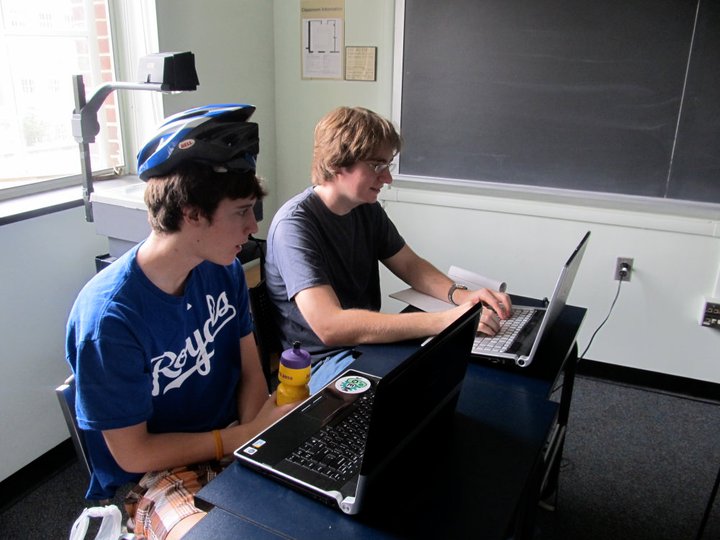Reporter: Week 2 May 23-27
From 2011.igem.org
(→Monday) |
|||
| Line 1: | Line 1: | ||
==Monday== | ==Monday== | ||
The reporters continued research on the linkers to hold the fusion proteins. | The reporters continued research on the linkers to hold the fusion proteins. | ||
| - | |||
==Tuesday== | ==Tuesday== | ||
| - | The reporter group decided on a few linkers to test in a fusion protein construct. These linkers are K243004 (4 amino acids), K105102 (10 amino acids) as well as the linker used in the Imperial College part, K316007. The reporters spent the rest of the time designing primers for PCR. We needed primers for the XylE part, the linker, the tev cleavage site and the GFP/flag tag complex of the Imperial College part, K316007, the CI repressor/RecA cleavage site, the LacZ part (J33210), the K243004 linker, and the K105012 linker. | + | [[File:Jim_and_Alex_research.jpg||thumb|right|400px|Jim explains yet another mind-blowing paper on protein fusions to Alex.]] |
| + | The reporter group decided on a few linkers to test in a fusion protein construct. These linkers are K243004 (4 amino acids), K105102 (10 amino acids) as well as the linker used in the Imperial College part, K316007. The reporters spent the rest of the time designing primers for PCR. We needed primers for the XylE part, the linker, the tev cleavage site and the GFP/flag tag complex of the Imperial College part, K316007, the CI repressor/RecA cleavage site, the LacZ part (J33210), the K243004 linker, and the K105012 linker. | ||
| + | |||
===Primers=== | ===Primers=== | ||
Note: | Note: | ||
Revision as of 14:42, 8 June 2011
Contents |
Monday
The reporters continued research on the linkers to hold the fusion proteins.
Tuesday
The reporter group decided on a few linkers to test in a fusion protein construct. These linkers are K243004 (4 amino acids), K105102 (10 amino acids) as well as the linker used in the Imperial College part, K316007. The reporters spent the rest of the time designing primers for PCR. We needed primers for the XylE part, the linker, the tev cleavage site and the GFP/flag tag complex of the Imperial College part, K316007, the CI repressor/RecA cleavage site, the LacZ part (J33210), the K243004 linker, and the K105012 linker.
Primers
Note:
Green font indicates junk DNA ends (binding sites).
Red font indicates annealing sites.
CAPITAL LETTERS INDICATE PREFIX AND SUFFIX.
lowercase letters indicate gene of interest.
Linker used in K316007
- designed by Ben
Annealing Temperature: 54.13°C
Sequence: 5’ TATTGAATTCGCGGCCGCTTCTAGATGGCCGGCggaggttcaggaggcagcACCGGTTAATACTAGTAGCGGCCGCTGCAGTATT 3’
Forward: 5’ TATTGAATTCGCGGCCGCTTCTAGATGGCCGGCggaggttcagg 3'
Reverse: 5’ AATACTGCAGCGGCCGCTACTAGTATTAACCGGTgctgcctcctgaacctccGC 3’
K105102: 10 Amino Acid Linker
- designed by Brian
Annealing Temperature: 56.3°C
Sequence: 5' TATTGAATTCGCGGCCGCTTCTAGATGGCCGGCggtgaaaatttgtattttcaatctggtggtACCGGTTAATACTAGTAGCGGCCGCTGCAGTATT 3'
Forward: 5' TATTGAATTCGCGGCCGCTTCTAGATGGCCGGCggtgaaaatttgtattttcaa 3'
Reverse: 5' AATACTGCAGCGGCCGCTACTAGTATTAACCGGTaccaccagattgaaaatacaaattttcacc 3'
K243004: 4 Amino Acid Linker
- designed by Alex
Annealing Temperature: 57.78°C
Sequence: 5' TATTGAATTCGCGGCCGCTTCTAGATGGCCGGCggtggttctggtACCGGTTAATACTAGTAGCGGCCGCTGCAGTATT 3'
Forward: 5' TATTGAATTCGCGGCCGCTTCTAGATGGCCGGCggtggttctggtACC
Reverse: 5' AATACTGCAGCGGCCGCTACTAGTATTAACCGGTaccagaaccaccG 3'
tev Cleave Site
- designed by Jim
Annealing Temperature: 55.83°C
Sequence: 5' ATTAGAATTCGCGGCCGCTTCTAGATGGCCGGCgagaatttgtattttcagggtACCGGTTAATACTAGTAGCGGCCGCTGCAGATTA 3’
Forward: 5' ATTAGAATTCGCGGCCGCTTCTAGATGGCCGGCgagaatttgtattttcaggg 3'
Reverse: 5' TAATTAATCTGCAGCGGCCGCTACTAGTATTAACCGGTaccctgaaaatacaaattctc 3'
cI Cleave Site
- designed by Jim
Annealing Temperature: 56.13°C
Sequence: 5' ATTAGAATTCGCGGCCGCTTCTAGATGGCCGGCgttcaggcagggatgttctcaACCGGTTAATACTAGTAGCGGCCGCTGCAGATTA 3’
Forward: 5' ATTAGAATTCGCGGCCGCTTCTAGATGGCCGGCgttcaggcagggatgttc
Reverse: 5’ TAATCTGCAGCGGCCGCTACTAGTATTAACCGGTtgagaacatccctgcctg 3’
XylE Part of K316007
- designed by Ben
Forward: 5’ TATTGAATTCGCGGCCGCTTCTAGATGGCCGGCaacaaaggtgtaatgcgac 3’
Reverse: 5’ TATTCTGCAGCGGCCGCTACTAGTATTAACCGGTggtcagcacggtcatg 3’
J33210: LacZ
- designed by Brian
Annealing Temperatures: Forward=57.74°C Reverse=55.05°C
Forward: 5' TATTGAATTCGCGGCCGCTTCTAGATGGCCGGCaccatgattacggattcac 3'
Reverse: 5' ATAACTGCAGCGGCCGCTACTAGTATTAACCGGTtcactccagccagc 3'
GFP and Flag Tag from K316007
- designed by Alex
Annealing Temperatures: Forward=56.88°C Reverse=59.95°C
Forward: 5' TATTGAATTCGCGGCCGCTTCTAGATGGCCGGCcgtaaaggagaagaacttttc 3'
Reverse: 5' AATACTGCAGCGGCCGCTACTAGTATTAACCGGTcttgtcgtcatcatctttataat 3'
Wednesday
The reporters designed primers for site-directed gene mutagenesis for the XylE gene in order to eliminate the restriction sites from the XylE gene. These are the primers:
Note: Red font shows the mutagenesis site
Mutation 1: bp315 NgoMIV Site I
Annealing Temperature: 79.49°C
Original Sequence: 5' GGC CGG CGC GTG CGC TTC C 3'
Forward: 5' GGC CGA CGC GTG CGC TTC C 3'
Reverse: 5' G GAA GCG CAC GCG ATCG GCC 3'
Mutation 2: bp 486 XylE NgoMIV Site II
Annealing Temperature: 70.54°C
Original Sequence: 5' C GAC GAA TTG CCG GCG ACC TAT GAC C 3'
Forward: 5' C GAC GAA TTG CCC GCG ACC TAT GAC C 3'
Reverse: 5' G GTC ATA GGT CGC GGG CAA TTC GTC G 3'
Mutation 3: bp 837 XylE Agel
Annealing Temperature: 79.16°C
Original Sequence: 5' CAC AAA CCG GTG ACC TGG ACC ACC G 3'
Forward: 5' CAC AAA CCC GTG ACC TGG ACC ACC G 3'
Reverse: 5' C GGT GGT CCA GGT CAC GGG TTT GTG 3'
Thursday
The reporter group also began assembly of a construct featuring the XylE gene (with RBS) and a lac inducible promoter. This construct will be used to test the reporting system before the sensor system is created. Ben and Alex transformed the Plac and the XylE gene. The Plac part is R0010 and the XylE part is J33204.
Friday
The reporter group ran colony PCR on the created colonies then ran the results on a gel. The gel showed that the construct consisted of less than 500 base pairs, but should have been over 1100 base pairs. We think that only the lac inducible promoter showed up in our colonies. As a result of this set back, we will have to redo assembly next week.
 "
"
